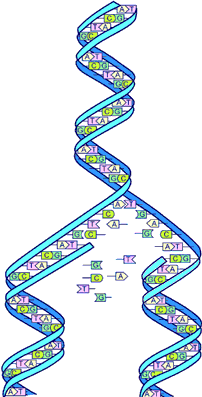DNA
 |
| DNA replication (image from DOE Human Genome project |
Deoxyribonucleic acid (DNA) is the molecule in living things that contains the coding information for creating proteins. It is also the molecule of heredity--whenever an organism reproduces, each offspring gets a copy of its parents' DNA.
Structurally, nucleic acids are giant polymers composed of units called nucleotides, each of which consists of a sugar, a phosphate, and a base. The sugar in DNA is deoxyribose. The four bases are adenine, cytosine, thymine, and guanine. Each can readily form hydrogen bonds to one of the others--A with T, C with G--so that two matching strands of DNA will group together in a double helix. The beginning of the strand is called 3' and the end 5'; these numbers refer to carbons in deoxyribose. The 3' end of one strand is next to the 5' end of the other; such an arrangement is called a crab canon. This form is called B-DNA; there are a few others.
The reason why thymine is used in DNA and uracil in RNA needs some explanation. Thymine is created from uracil in a methylation process, which is energetically expensive. In other words, uracil is cheaper for a cell than thymine. Unfortunately cytosine becomes deaminated with significant ease to become uracil. If uracil were used in DNA, it would result in many mutations going uncorrected, as there would be no way to tell the difference between a uracil and a deaminated cytosine. By using thymine in the genetic code instead of uracil, all uracils created in such way can be removed and replaced with cytosine using the guanine base on the opposite strand of DNA as a template. The cheaper uracil is used in RNA because RNA doesn't need to last a long time anyway.
DNA does not code for any proteins directly. Instead, matching strands of messenger RNA (mRNA) are formed by enzymes called RNA polymerases--this is called "transcription"--which are sent off into the cytoplasm for translation in the ribosomes. Other kinds of RNA are also formed to help in the process--tRNA, rRNA, and snRNA. The genetic code used by these molecules to encode the sequence of proteins is highly conserved, nearly universally so. This suggests that all life on Earth is descended from a single original strain of living matter.
In bacteria there is a single main strand of DNA, copied over when the cell replicates. There may also be small pieces of circular DNA called plasmids floating in the cytoplasm that can be exchanged between cells. In eukaryotes there are typically multiple pieces of DNA contained in a central nucleus, separated out in cell division by a process called mitosis. There may be a single copy of the genome (whence the organism is haploid), two copies (diploid), or many copies (polyploid).
In preparation for sexual reproduction, haploid cells are produced from a diploid precursor in a process called meiosis. Eventually some haploid cells unite together to form a new diploid cell (syngamy) with half its genome from each diploid ancestor. When there are different versions of the same gene, their effects may be blended or a single version may be dominant.
See also: Ploidy, Biology, Genetics.
The discovery of DNA
The structure of nucleic acids was discovered in the C19. Later it was found that the sugar in nucleic acid could be either ribose (RNA) or deoxyribose (DNA). In 1943, Oswald Theodore Avery proved that DNA carries genetic information and suggested DNA might actually be the gene.
In 1948, Linus Pauling discovered that many proteins take the shape of an alpha helix. In 1950, biochemist Erwin Chargaff found that the arrangement of bases in DNA varied, but the amount of certain bases always occurred in a one-to-one ratio.
In England two separate investigations into DNA took place in the 1950s. At Cambridge University, Francis Crick and James Watson were making physical models to eventually create an accurate picture of the molecule. At Kings College in London, Maurice Wilkins and Rosalind Franklin were examining X-ray diffraction images of DNA.
In 1951, Watson attended a lecture by Franklin on her work to date. She had found that DNA can exist in two forms. From this she had deduced that the phosphate part of the molecule was on the outside. Based on an imperfect recollection of her information, Watson and Crick made a failed model. Franklin had also found that the X-ray diffractions of one of the forms of DNA had the characteristics of a helix. She suspected that DNA was helical but did not announce this.
Watson and Crick made a crucial step, suggesting the molecule was made of two nucleotide chains, each in a helix as Franklin had found, but one going up and the other going down. Crick learned of the work of Chargaff in 1952. He added that to the model, so that matching base pairs interlocked to keep the distance between the chains constant. This model showed that each strand of the DNA molecule was a template for the other. The fit with experimental data was such that it was almost immediately accepted. Their paper 'A structure for Deoxyribose Nucleic Acid' was published in April 1953. further research uncovered how DNa made proteins in 1957.
In 1962, Watson, Crick, and Wilkins won the Nobel Prize for physiology/medicine, Franklin had died.
Space-filling model of a section of DNA molecule. Phosphorous is in yellow, showing the sugar-phosphate backbone with the dark blue of the nucleotide bases in the core of the helix. The major and minor grooves of the DNA helix are readily apparent.
